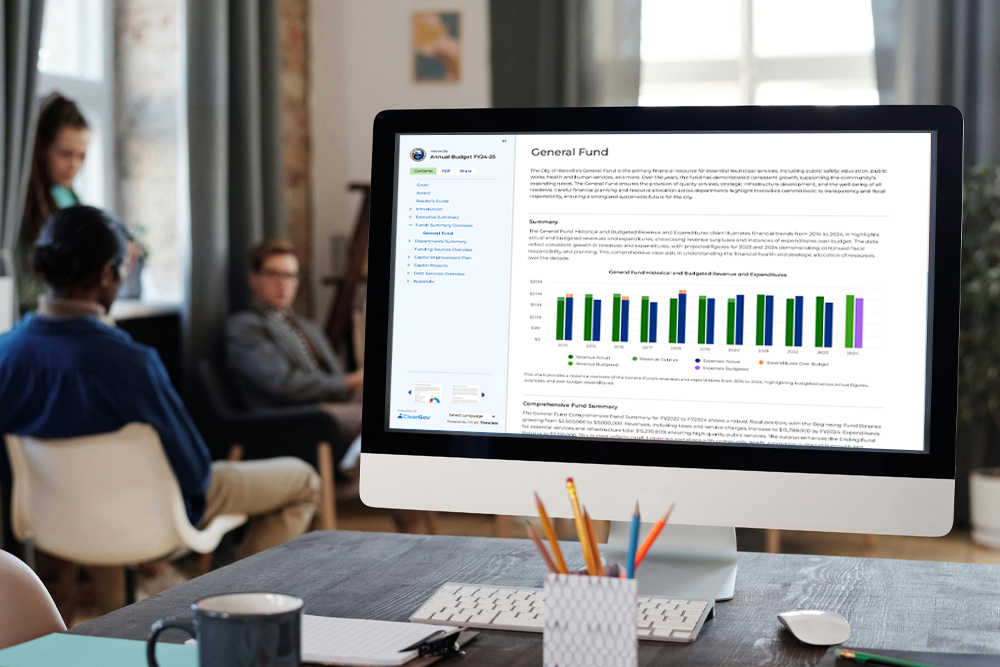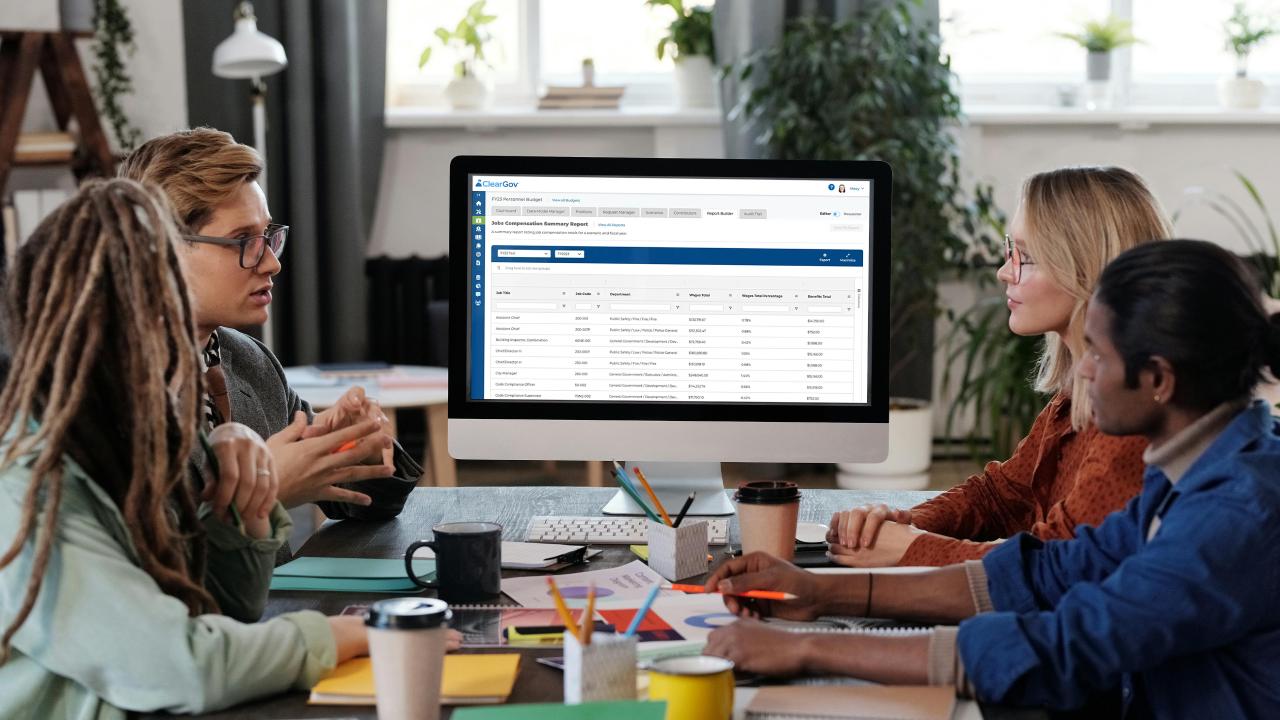Budget planning is strategic, organized, and collaborative. But the road to budget excellence can be a bumpy one!
Adopting and adhering to consistent best practices in budgeting can help local governments build trust and gain buy-in from their community members. It also improves internal collaboration and alignment for a more effective and efficient budget cycle.
If you strive to budget better in 2023, start with these 14 best practices.
Planning The Budget
One of the biggest challenges local governments face is pushback from their community. Citizens want to know “why” certain expenses are needed, and they want to know how officials prioritize some projects over others.
You can minimize these challenges and foster civic engagement in the early stages of your budgeting process.
Some best practices to implement include:
- Include citizens in planning – Hold town hall meetings, send out surveys, and engage citizens on social media to get their feedback on certain projects or services you’re considering. Find out what’s important to your community and how your budget can support it.
- Share your strategy and goals – Be transparent about how you prioritize capital projects or new budget requests. Do you use software to automatically score requests so that it’s completely objective, or do council members vote based on supporting documentation provided? Is there a way you can involve citizens to get their feedback and buy-in?
- Tie goals to performance measures – Share what metrics will be used to measure the performance of your goals. What strategies will be used to achieve those goals? Sharing this information with citizens and internal stakeholders helps them understand the why behind decisions and keeps the government accountable for continually working toward those goals using taxpayer dollars responsibly.
- Plan for the future – Creating data-driven, strategic multi-year plans is necessary for your own internal planning. It also helps citizens better connect expenses with goals as the years progress. Creating accurate multi-year plans in a spreadsheet can be challenging. A cloud-based budgeting tool can help you automate the process and analyze multiple scenarios against the big picture of your budget.
Creating The Budget
The back-and-forth collaboration between department heads and the finance team can be challenging to manage. Lost emails, organizing and storing supporting documentation, and controlling access to spreadsheets can overheat in even the most well-oiled machine.
Having processes in place and managing expectations can facilitate more efficient collaboration.
Some best practices to implement include:
- Document and communicate the process – Before getting started, department heads should understand the process and what’s expected of them. Visuals, like graphs, flowcharts, and calendars, can help department heads and the finance department stay on track.
- Set deadlines and automatic reminders – Clearly communicate deadlines for requests and changes to department heads. Use your budgeting software tool or your company’s email/calendar platform to send reminder emails automatically.
- Organize supporting documentation – Bids, photos, testimonials, and any other supporting documentation should be clearly organized and attached to each budget request. This can be challenging as some content may be paper (like a letter from a citizen), while some may be digital. If you’re not using a cloud-based budgeting solution, it’s a good idea to convert everything to digital format, organize it in a shared folder, and attach a link to the request.
- Consolidate communication – Whether you’re using a budgeting tool or Excel, keep all communication inside the platform. This eliminates lost emails and can minimize phone calls and meetings.
- Reduce errors – Anytime you’re using spreadsheets with links and formulas, there is a chance for errors during data entry and manual consolidation. There really isn’t a great workaround for this challenge in Excel. But, when you’re ready to modernize your budgeting process, a cloud-based solution provides tight access and version controls while automatically making calculations to eliminate formulas.
Communicating The Budget
Your budget may function as a policy document, financial plan, and operations guide for your organization, but it should also be used as a communication tool to engage your citizens. If complex financial data is buried in a 300-page PDF on your website, the reality is that very few people will read it.
Engage citizens by making both the data and the budget document accessible and easy to understand.
Some best practices to implement include:
- Use clear, simple language – Remember that the majority of your citizens are not financial folks. Use language that the average person can understand, provide information your citizens will find useful, and have some non-financial staff members review your budget document before publishing it.
- Be transparent – Local governments have a fiduciary responsibility to use tax dollars appropriately. Provide background information and justification to help citizens understand the budgeting process. If there are any discrepancies or potential opportunities to misinterpret data, be proactive and address them openly and provide context. Some governments that use online transparency portals even go so far as to host an open checkbook feature so that citizens can pop in anytime and see recent transactions.
- Utilize charts and graphs – Visual elements can make complex data easier to understand. If you’re using a web-based budget presentation, you can go a step further and use interactive graphs so that users can toggle between graph types (i.e. bar charts or pie charts) to make the data make the most sense to them.
- Be consistent with messaging – Repetition, when you honor your word, builds trust. Maintain consistent messaging to instill confidence in your community that their government has their best interests in mind. Use the same messaging across all platforms where you engage with citizens: town hall meetings, social media, website content, email messages, etc.
- Encourage feedback – Your budget shouldn’t be a one-way street. Encourage citizens to share questions, concerns, or suggestions. You can do this by including a form on your website or emailing a survey. If you use a cloud-based solution, you can even turn on comments on certain items, like proposed capital improvement projects, to encourage open dialogue.
Want To Modernize Your Budgeting Process In 2023?
If those little nuggets we dropped about cloud-based budgeting solutions caught your attention, 2023 may be the year you decide to ditch spreadsheets and modernize your budgeting process.
ClearGov offers a complete suite of Budget Cycle Management software solutions that streamline and automate the entire process, from start to finish. Contact us today to schedule a quick demo.













